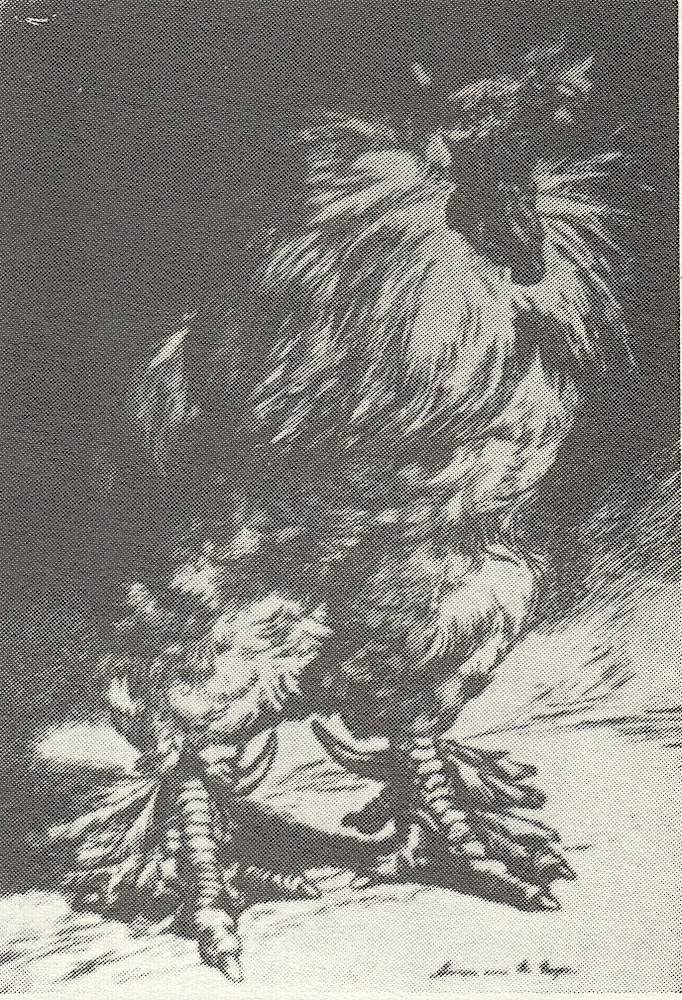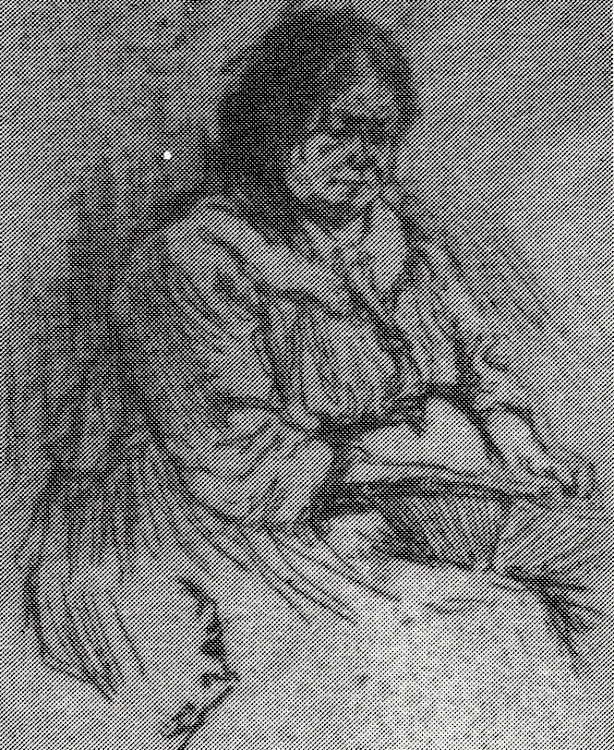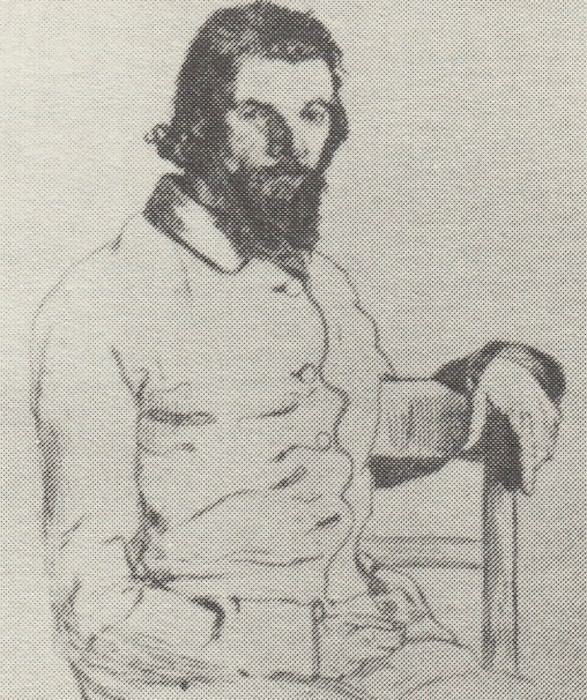This article first appeared in the Journal of the Royal Society of Painter-Etchers and Engravers, No 9 (January 1987), pp. 37-39, and is reproduced here, with the original illustrations, by kind permission of the author's wife, Catriona Blaker. You may use the images without prior permission for any scholarly or educational purpose as long as you (1) credit the author and (2) link your document to this URL in a web document or cite the Victorian Web in a print one. [Click on the images to enlarge them.] — Jacqueline Banerjee.

Le Haut d'un Battant de Porte. Etching. F[élix] Bracquemond.
It is not always remembered — in fact it is probably not remembered at al — that the R.E. [Royal Society of Painter-Etchers and Engravers] in its earlier days, was of a cosmopolitan nature. From about the 1860s onward an increasingly larger number of British painters studied in Paris; and indeed it became de rigueur for any talented artist here to finish his education by a period at a Parisian atelier. Consequently, British artists had many friends and colleagues among the Parisian artists. It is interesting that in those days of easy travel one could go back and forth on the steamers and trains at little cost and difficulty — you could even take your dog, I dare say — and it was a common habit to go over regularly to France in order to paint, work, sketch and seek new subjects and renew old ties. This would have been of course more the case among fairly successful artists who were establishing themselves, or who were established; but in those days art was not wholly difficult for the public to accept — in fact very largely the opposite — and many artists lived by their art — something we are led to understand today is of a rarer frequency.
So, without the limitation upon them of full-time art-teaching and term-times and examination markings, it is presumed there was much greater fraternity then between the two countries artistically. At all events, the list of distinguished French etchers who were early members of the R.E. is impressive. They were not all actual founders, but no more were all the British etchers. By degrees, however, more and more were drawn in, under Haden’s sensible and far-seeing direction. Despite his autocracy — perhaps because of it — the R.E. increased its comprehensive inclusion of etching talent. Tissot — himself resident in London for a most inspired period — was in fact one of the original few members. Of the distinguished French etchers who were further to make up the contingent included Legros, who had settled permanently in England, and in due course [Gustave] Leheutre [1861-1932], [Félix] Braquemond [1833-1914], [Paul César] Helleu [1859-1927],[Félix] Buhot [1847-1898], [Edgar] Chahine [1874-1947], Leon L’Hermitte [1844-1925]and others. Although in later days we have taken the excellent step, from time to time, of electing foreign printmakers as Honorary Members — and indeed S[tanley] W[illiam] [37/38] Hayter [1901-1988] sent a fine body of work for selection for inclusion in the 1987 Spring show at the Bankside — we have not had the same duo-National membership across the century as when we commenced. Hayter, though English, is so much a Parisian as to seem French.


Left: Belgian Girls. Etching. Alphonse Legros (Ed Coll.). Right: Vive le Tsar. Etching. Félix Bracquemond.
Bracquemond was essentially one of those artists who works best in etching — or at least, those are the works for which he is most familiar. Vive le Tsar is perhaps the most exuberantly enthusiastic plate ever needled. And then, again, possibly its exact opposite, there is his highly original but possibly depressing subject of an array of victims pinned by a gamekeeper to a barn door.
Chahine is a brilliant artist of highly varying quality. At his best, with Paris street scenes, fairground subjects and elaborate compositions with street types, stalls and sideshows he is at his most personal. Also, with Helleu, he was a marvellour delineator of the female when the great hats and feathers and beautiful styling of women’s clothes was a gift to the artist.
In plates by these etchers, as with the paintings of Sargent and Boldini, we find an elegance that we are obliged to believe in. It is perhaps sad that when we look at photographs of the time — even those that dwell, like Lartigue, upon the fashionable and stylish — we find that the great hats in fact tend to diminish if anything the fairly prevalent shortness of height of the wearers. But possibly it is the function of art to delude us while it is pandering to our aesthetic tastes.



Left to right: (a)St Nicolas-des-champs, Paris. Etching. Eugène Béjot (Ed. Coll.). (b) Pearl Stringer. Etching. Edgar Chahine. (Ed. Coll.). (c) Portrait of Charles Méryon. Etching. Félix Bracquemond.
Buhot of all etchers, is the man on his own. These rainy days, so full of blustrous atmosphere — the evocative cabhorse stand, the Place Pigalle horsebus or diligence waiting, people disembarking from Channel boats in torrential gales — and every margin packed with sketches and scribbles and vignettes as if to irritate the purist art critics — which they did, very successfully. Twenty years ago you could buy them for five pounds. Now they will cost you nearly as many thousands. And rightly so. Legros is a powerful artist, but not too likeable. He has a dismalness to him, a passion for morbid subjects — not to our taste today — that follows through into the work of his follower Strang. It is a dully depressive streak that seems to admit of no hope, nor even wish for it. I myself find them rather consoling to have about, and collect them avidly. They are almost cosy, like enjoying bad weather from a comfortable room indoors. Probably they do not go very deep after all, but perhaps that is an advantage. The real [37/38] horror of a Goya print one can hardly live with; and my own rather superficial taste finds him not only horrible but rather dislikeable in almost every sense. But this appears not to be the usual view. I am a [Max] Klinger [1857-1920] admirer as regards the uncomfortable in art treated with profound intelligence. Of course, Chahine was not in fact French but Armenian; however, being based in Paris seems to nationalise him in some ways. A most unfortunate artist — his countrymen slaughtered in Turkish pogroms, his young wife dying, his studios burnt down or flooded — his paintings plates and prints continually being lost and destroyed ... still he works on, even surviving his own Nineties and Edwardian era to make plates of beach-scene bathers in the Thirties, a millennium away, and to survive even the second world war.
Tissot’s etchings work with his paintings in that the one often appears to be of inspiration for both. The prints of Mrs. Newton in the garden at St. John’s Wood are to my mind his finest prints — inspired by that extra perception an artist possesses about a model with whom he is emotionally involved — quite possibly in the first place because of the attraction of her appearance artistically. But Tissot, like Chahine, was fated to be bereaved after but a few short years with his inspiring partner, and returning to Paris worked for a while on memory images of her — a sadly deprived existence for the unfortunate artist.
Created 20 June 2020